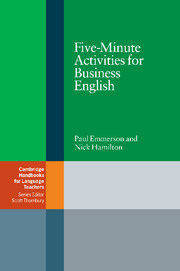Book contents
- Frontmatter
- Contents
- Thanks and Acknowledgements
- Introduction
- 1 Business topics: jobs and careers
- 2 Business topics: the company
- 3 Business topics: products and services
- 4 Business topics: management and marketing
- 5 Business topics: money and finance
- 6 Business topics: information technology
- 7 Business topics: cultural awareness
- 8 Business communication skills: telephoning
- 9 Business communication skills: meetings and negotiations
- 10 Business communication skills: presentations
- 11 Business communication skills: social English
- 12 Language work: speaking
- 13 Language work: writing
- 14 Language work: listening
- 15 Language work: reading
- 16 Language work: pronunciation
- 17 Language work: vocabulary
- 18 Language work: grammar
- 19 Exploiting coursebooks
- Index
Introduction
Published online by Cambridge University Press: 03 May 2010
- Frontmatter
- Contents
- Thanks and Acknowledgements
- Introduction
- 1 Business topics: jobs and careers
- 2 Business topics: the company
- 3 Business topics: products and services
- 4 Business topics: management and marketing
- 5 Business topics: money and finance
- 6 Business topics: information technology
- 7 Business topics: cultural awareness
- 8 Business communication skills: telephoning
- 9 Business communication skills: meetings and negotiations
- 10 Business communication skills: presentations
- 11 Business communication skills: social English
- 12 Language work: speaking
- 13 Language work: writing
- 14 Language work: listening
- 15 Language work: reading
- 16 Language work: pronunciation
- 17 Language work: vocabulary
- 18 Language work: grammar
- 19 Exploiting coursebooks
- Index
Summary
The need for short activities in Business English
There are many situations where Business English teachers need short activities, for example:
a warmer to provide the transition from the students' daily life to the world of the Business English classroom
a lead-in for whatever business topic or communication skill will be the main focus of the lesson
an activity to introduce or extend a speaking or writing task
an idea for working with an interesting reading or listening text
an activity to focus on or review an area of vocabulary, grammar or pronunciation
an activity to practise something covered in a previous lesson
a way to round off the lesson
As well as being useful in putting lessons together, short activities may also help in dealing with the unpredictable situations common to Business English teaching such as erratic attendance on in-company courses, covering for another teacher at short notice, or doing tutorials with individual students to cater for specific needs.
The activities
Organisation
We have organised the activities under the following headings and sub-headings to make it easy for you to find something appropriate for the lesson you are planning:
Business topics: jobs and careers, the company, products and services, management and marketing, money and finance, IT, cultural awareness. These activities lead into the main focus of a lesson, in terms of both business content and key language.
Business communication skills: telephoning, meetings and negotiations, presentations, social English. These activities cover the main business communication skills, looking at the nature of the skill itself and the relevant language.
- Type
- Chapter
- Information
- Five-Minute Activities for Business English , pp. 1 - 3Publisher: Cambridge University PressPrint publication year: 2005



